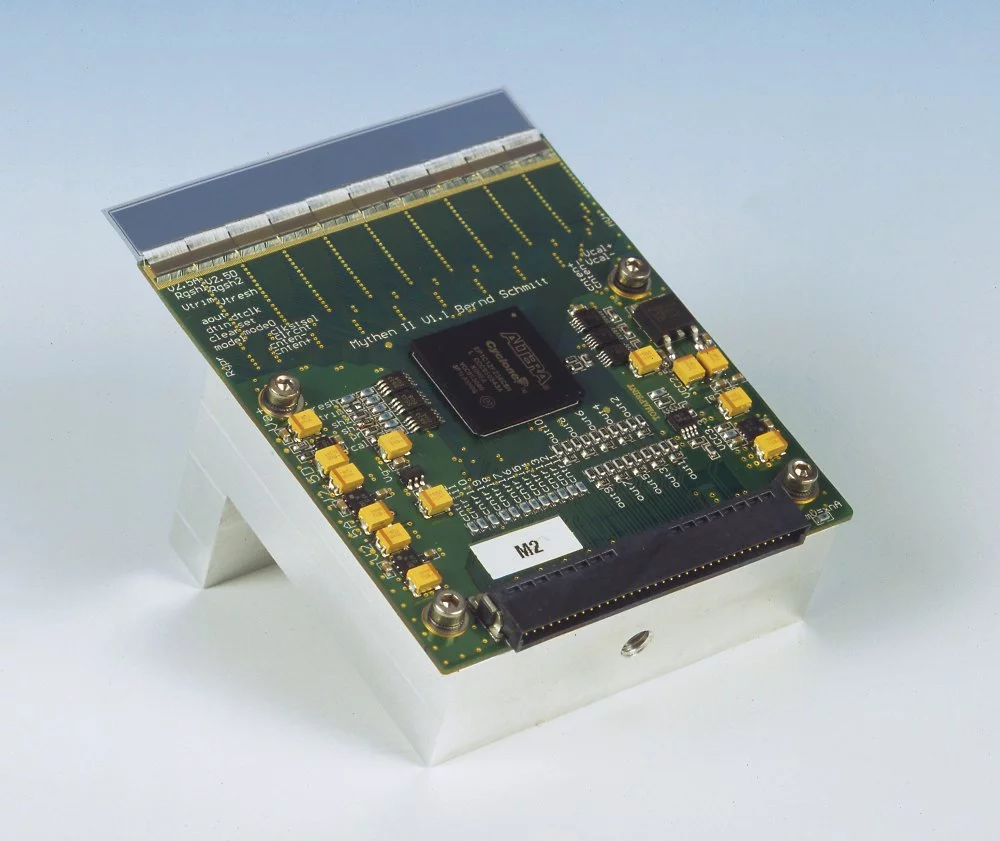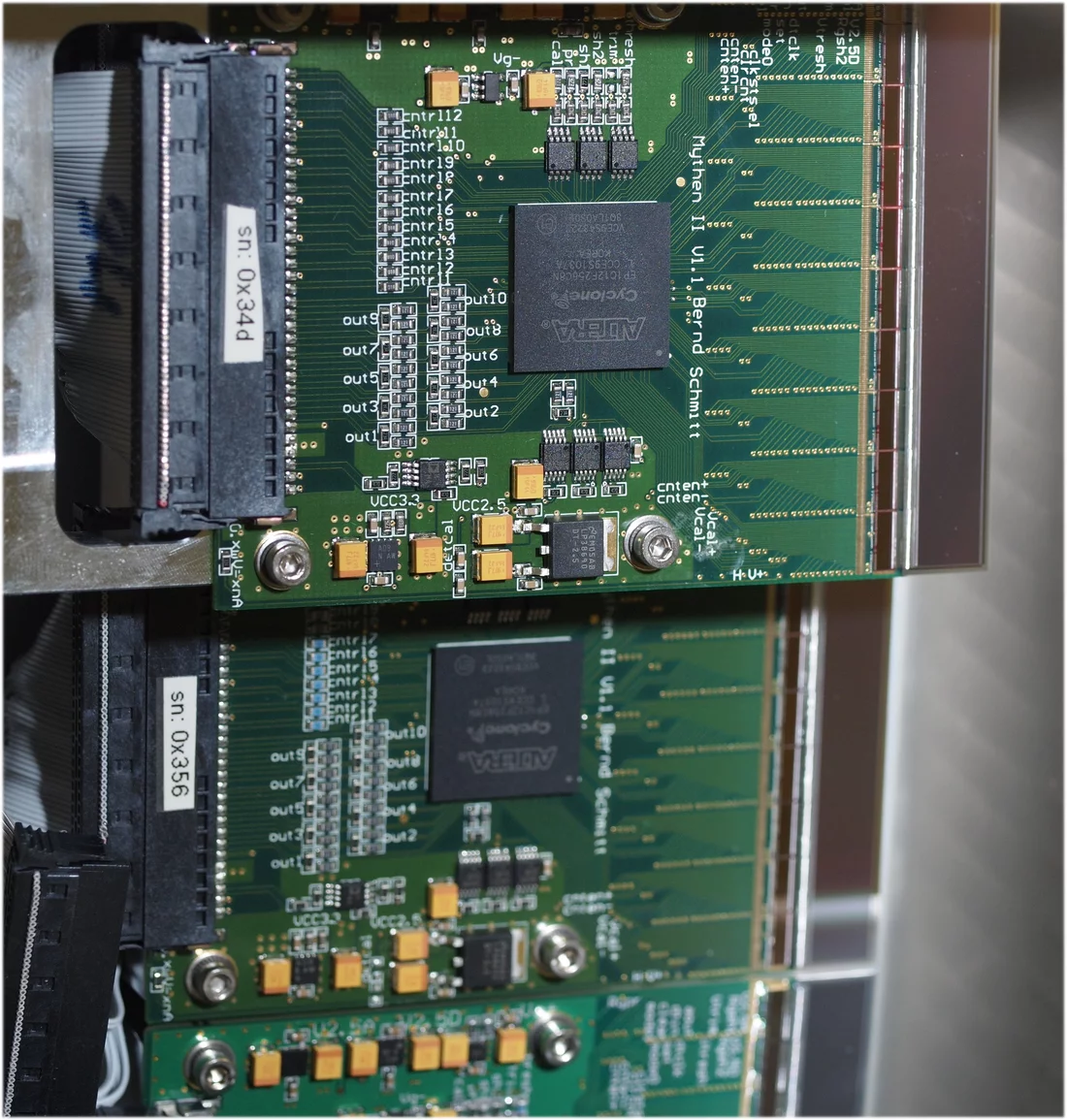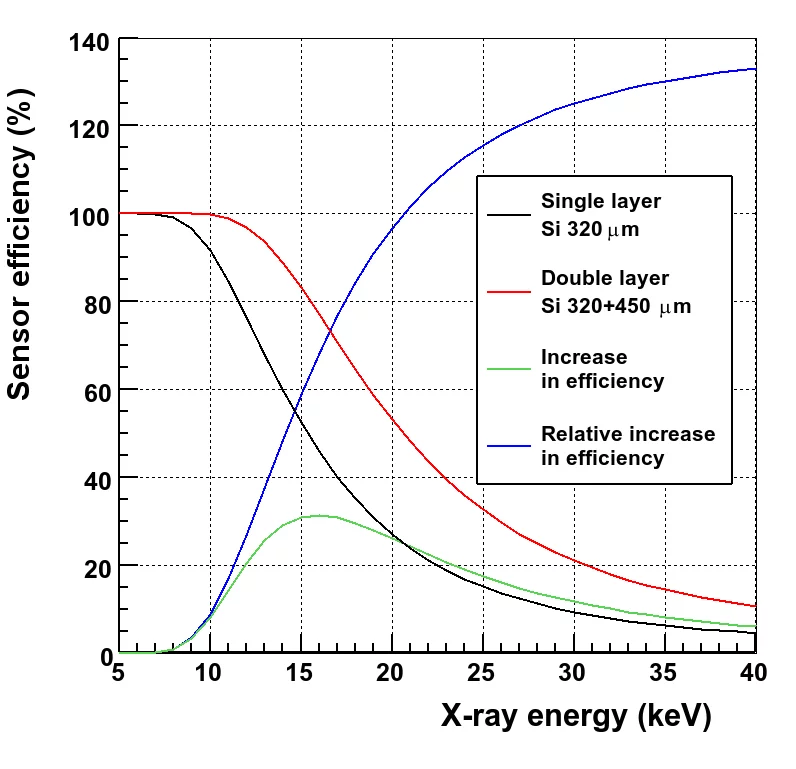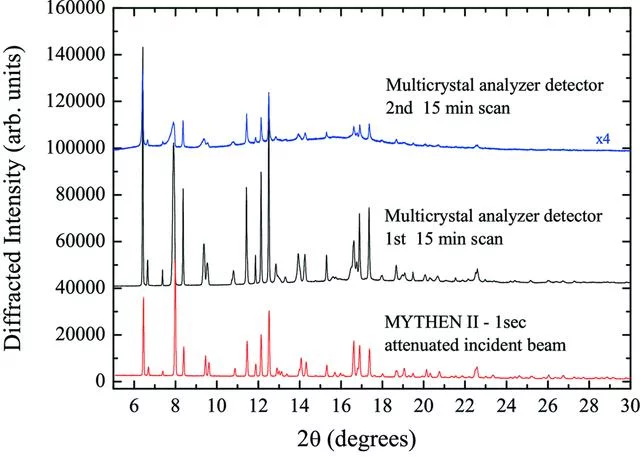MYTHEN is a 1D detector working in single-photon counting mode and meeting the high standards of synchrotron radiation experiments. It features low noise, high dynamic range, and excellent spatial resolution. Additionally, its numerous independent channels enable parallel data acquisition and facilitate time-resolved measurements at frame rates of up to 1 kHz, making it ideal for a wide range of applications in photon science.
Detector description
The MYTHEN detector features a modular design that allows for the construction of larger systems to enhance area coverage. Each module consists of 1280 independent channels operating in parallel in single-photon counting mode, connected to strips of a silicon sensor. The detector achieves a spatial resolution of 50 μm, given by the strip pitch, with a sensor thickness of 320 μm and strip length of 8 mm. As a single-photon counting detector, MYTHEN offers virtually noiseless operation with a dynamic range of up to 24 bits, enabling the detection of low-energy photons down to 5 keV and high counting rates of up to 1 MHz/channel. It supports frame rates of up to 1 kHz with an inter-frame dead time of 0.07-0.25 ms and allows acquisition times down to 100 ns and synchronization with external trigger signals. A small onboard memory can store multiple frames in real time, enhancing data acquisition flexibility. Tailoring to different application requirements, custom sensors with various geometrical characteristics or materials are available.
MYTHEN III
After 12 years of operation at the Material Science beamline, MYTHEN was upgraded to MYTHEN III, featuring a readout chip with reduced noise and threshold dispersion for improved low-energy operation and fluorescence discrimination. The new design supports a count rate above 1 MHz per channel and incorporates three independent trimmable comparators per channel with gateable counters for advanced experimental capabilities such as multiple time slots, energy binning, or pileup-tracking to increase the count rate. With an upgraded readout and mechanical system, MYTHEN III can achieve a frame rate exceeding 1 MHz (when using 1 bit for a single counter and several kHz with all 3 counters, 24 bit dynamic range) and enables single-shot diffraction pattern acquisition. It was installed at the MS beamline in early 2020.
Applications
MYTHEN was originally designed for powder diffraction measurments at the Material Science Beamline of the SLS. The system installed at the beamline is capable of acquiring 120° (in 2θ) diffraction patterns with sub-sec time resolution. Overall it consists in more than 40'000 channel acquiring independently in parallel and is optimal for time-resolved and dose-critical measurements.
Thanks to its outstanding performance and the calibration procedure developed at the SLS, the data quality is now comparable to that of traditional high-resolution detectors, with the further advantage of very fast data acquisition or, equivalently, very high counting statistics in acquisition times of the order of tens of seconds. MYTHEN is therefore also ideal for analyses of pair distribution functions (PDFs).
In 2012 the MYTHEN Detector has been upgraded by adding a second detector capable of detecting the hard X-rays transmitted by the first one. The use of thicker silicon sensors further increases the efficiency of the system, as shown in the pictures below.
MYTHEN modules are used also for several other type of experiments including energy dispersive spectrometers, beam position monitors and medical imaging.
Examples
Publications
-
Andrä M, Bergamaschi A, Baruffaldi F, Brückner M, Carulla M, Casati N, et al.
MYTHEN III: advancements in single photon counting detectors for synchrotron powder diffraction experiments
Journal of Synchrotron Radiation. 2025; 32(2): vl5033 (13 pp.). https://doi.org/10.1107/S1600577525000438
DORA PSI -
Bergamaschi A, Andrä M, Barten R, Baruffaldi F, Brückner M, Carulla M, et al.
First demonstration of on-chip interpolation using a single photon counting microstrip detector
Journal of Instrumentation. 2022; 17(11): C11012 (9 pp.). https://doi.org/10.1088/1748-0221/17/11/C11012
DORA PSI -
Spiliopoulou M, Karavassili F, Triandafillidis D-P, Valmas A, Fili S, Kosinas C, et al.
New perspectives in macromolecular powder diffraction using single-photon-counting strip detectors: high-resolution structure of the pharmaceutical peptide octreotide
Acta Crystallographica Section A: Foundations and Advances. 2021; 77: 186-195. https://doi.org/10.1107/S2053273321001698
DORA PSI -
Andrä M, Dinapoli R, Bergamaschi A, Barten R, Brückner M, Chiriotti Alvarez S, et al.
Towards MYTHEN 3: characterization of prototype chips
Nuclear Instruments and Methods in Physics Research, Section A: Accelerators, Spectrometers, Detectors and Associated Equipment. 2019; 936: 383-385. https://doi.org/10.1016/j.nima.2018.11.026
DORA PSI -
Andrä M, Barten R, Bergamaschi A, Brückner M, Casati N, Cervellino A, et al.
Towards MYTHEN III - prototype characterisation of MYTHEN III.0.2
Journal of Instrumentation. 2019; 14(11): C11028 (8 pp.). https://doi.org/10.1088/1748-0221/14/11/C11028
DORA PSI -
Osaka K, Yokozawa Y, Torizuka Y, Yamada Y, Manota M, Harada N, et al.
Versatile high-throughput diffractometer for industrial use at BL19B2 in SPring-8
In: Gwo S, Huang D-J, Wei D-H, eds. Proceedings of the 13th international conference on synchroton radiation instrumentation - SRI2018. Vol. 2054. AIP conference proceedings. sine loco: AIP Publishing; 2019:050008 (5 pp.). https://doi.org/10.1063/1.5084626
DORA PSI -
Ruat M, Andrä M, Bergamaschi A, Barten R, Brückner M, Dinapoli R, et al.
Photon counting microstrip X-ray detectors with GaAs sensors
Journal of Instrumentation. 2018; 13(1): C01046 (9 pp.). https://doi.org/10.1088/1748-0221/13/01/C01046
DORA PSI -
Elbracht-Leong S, Bergamaschi A, Greiffenberg D, Peake D, Rassool R, Schmitt B, et al.
Characterisation of an electron collecting CdTe strip sensor using the MYTHEN readout chip
Journal of Instrumentation. 2015; 10(1): C01024 (10 pp.). https://doi.org/10.1088/1748-0221/10/01/C01024
DORA PSI -
Grässlin J, McCusker LB, Baerlocher C, Gozzo F, Schmitt B, Lutterotti L
Advances in exploiting preferred orientation in the structure analysis of polycrystalline materials
Journal of Applied Crystallography. 2013; 46(1): 173-180. https://doi.org/10.1107/S0021889812045943
DORA PSI -
Bergamaschi A, Dinapoli R, Greiffenberg D, Henrich B, Johnson I, Mozzanica A, et al.
Time-over-threshold readout to enhance the high flux capabilities of single-photon-counting detectors
Journal of Synchrotron Radiation. 2011; 18(6): 923-929. https://doi.org/10.1107/S0909049511034480
DORA PSI -
Lopez FC, Rigon L, Longo R, Arfelli F, Bergamaschi A, Chen RC, et al.
Development of a fast read-out system of a single photon counting detector for mammography with synchrotron radiation
Journal of Instrumentation. 2011; 6(12): C12031 (6pp.). https://doi.org/10.1088/1748-0221/6/12/C12031
DORA PSI -
Bergamaschi A, Cervellino A, Dinapoli R, Gozzo F, Henrich B, Johnson I, et al.
The MYTHEN detector for X-ray powder diffraction experiments at the Swiss Light Source
Journal of Synchrotron Radiation. 2010; 17(5): 653-668. https://doi.org/10.1107/S0909049510026051
DORA PSI -
Fadenberger K, Gunduz IE, Tsotsos C, Kokonou M, Gravani S, Brandstetter S, et al.
In situ observation of rapid reactions in nanoscale Ni-Al multilayer foils using synchrotron radiation
Applied Physics Letters. 2010; 97(14): 144101 (3 pp.). https://doi.org/10.1063/1.3485673
DORA PSI -
Gozzo F, Cervellino A, Leoni M, Scardi P, Bergamaschi A, Schmitt B
Instrumental profile of MYTHEN detector in Debye-Scherrer geometry
Zeitschrift für Kristallographie: Crystalline Materials. 2010; 225(12): 616-624. https://doi.org/10.1524/zkri.2010.1345
DORA PSI -
Bergamaschi A, Cervellino A, Dinapoli R, Gozzo F, Henrich B, Johnson I, et al.
Photon counting microstrip detector for time resolved powder diffraction experiments
Nuclear Instruments and Methods in Physics Research, Section A: Accelerators, Spectrometers, Detectors and Associated Equipment. 2009; 604(1-2): 136-139. https://doi.org/10.1016/j.nima.2009.01.092
DORA PSI -
Mozzanica A, Bergamaschi A, Dinapoli R, Gozzo F, Henrich B, Kraft P, et al.
MythenII: a 128 channel single photon counting readout chip
Nuclear Instruments and Methods in Physics Research, Section A: Accelerators, Spectrometers, Detectors and Associated Equipment. 2009; 607(1): 250-252. https://doi.org/10.1016/j.nima.2009.03.166
DORA PSI -
Rigon L, Arfelli F, Astolfo A, Bergamaschi A, Dreossi D, Longo R, et al.
A single-photon counting "edge-on" silicon detector for synchrotron radiation mammography
Nuclear Instruments and Methods in Physics Research, Section A: Accelerators, Spectrometers, Detectors and Associated Equipment. 2009; 608(Suppl. 1): S62-S65. https://doi.org/10.1016/j.nima.2009.05.036
DORA PSI -
Bergamaschi A, Broennimann C, Dinapoli R, Eikenberry E, Gozzo F, Henrich B, et al.
Performance of a single photon counting microstrip detector for strip pitches down to 10 μm
Nuclear Instruments and Methods in Physics Research, Section A: Accelerators, Spectrometers, Detectors and Associated Equipment. 2008; 591(1): 163-166. https://doi.org/10.1016/j.nima.2008.03.048
DORA PSI -
Rigon L, Arfelli F, Bergamaschi A, Dreossi D, Longo R, Menk R-H, et al.
PICASSO: a silicon microstrip detector for mammography with synchrotron radiation
In: Proceedings of the 2008 IEEE nuclear science symposium conference record, NMR-4. IEEE nuclear science symposium conference record. sine loco: IEEE; 2008:1536-1539. https://doi.org/10.1109/NSSMIC.2008.4775118
DORA PSI -
Vallazza E, Arfelli F, Bruni F, Castelli E, Longo R, Pontoni C, et al.
A double layer silicon detector for single photon counting
In: Astroparticle, particle and space physics, detectors and medical physics applications - proceedings of the 10th conference. Astroparticle, particle and space physics, detectors and medical physics applications - proceedings of the 10th conference. Singapore: World Scientific Publishing Co. Pte Ltd; 2008:700-705. https://doi.org/10.1142/9789812819093_0117
DORA PSI -
Dreossi D, Bergamaschi A, Schmitt B, Vallazza E, Arfelli F, Longo R, et al.
Clinical mammography at the SYRMEP beam line: toward the digital detection system
Nuclear Instruments and Methods in Physics Research, Section A: Accelerators, Spectrometers, Detectors and Associated Equipment. 2007; 576(1): 160-163. https://doi.org/10.1016/j.nima.2007.01.145
DORA PSI -
Rosciano F, Holzapfel M, Kaiser H, Scheifele W, Ruch P, Hahn M, et al.
A multi-sample automatic system for in situ electrochemical X-ray diffraction synchrotron measurements
Journal of Synchrotron Radiation. 2007; 14(6): 487-491. https://doi.org/10.1107/S0909049507039209
DORA PSI -
Schmitt B, Brönnimann C, Eikenberry EF, Hülsen G, Toyokawa H, Horisberger R, et al.
Development of single photon counting detectors at the Swiss Light Source
Nuclear Instruments and Methods in Physics Research, Section A: Accelerators, Spectrometers, Detectors and Associated Equipment. 2004; 518(1-2): 436-439. https://doi.org/10.1016/j.nima.2003.11.051
DORA PSI -
Schmitt B, Brönnimann C, Eikenberry EF, Gozzo F, Hörmann C, Horisberger R, et al.
Mythen detector system
Nuclear Instruments and Methods in Physics Research, Section A: Accelerators, Spectrometers, Detectors and Associated Equipment. 2003; 501(1): 267-272. https://doi.org/10.1016/S0168-9002(02)02045-4
DORA PSI
Team
| Person | Position | Phone Nr. | |
|---|---|---|---|
| Dr. Anna Bergamaschi | Group Leader Detector Science and Characterization
|
||
| Dr. Roberto Dinapoli | Microelectronics Engineer, leader of the chip design group
|









